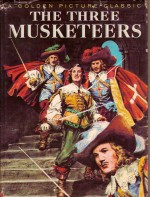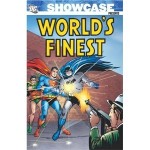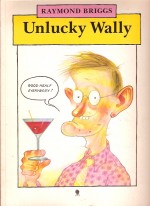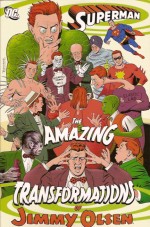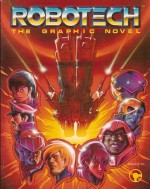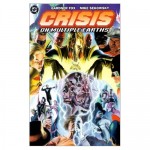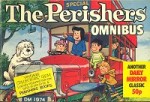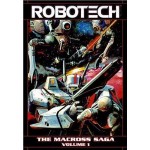
By Jack Herman, Carl Macek, Mike Baron, Reggie Byers, Neil D. Vokes, Ken Steacy & various (WildStorm)
ISBN: 978-1-84023-713-9
Robotech was a minor comics/TV crossover phenomenon of the 1980s based on some rather deft remarketing of assorted Japanese fantasy exports. Whilst American TV company Harmony Gold was cobbling together and re-editing three separate weekly science fiction anime series (Super Dimension Fortress Macross, Super Dimension Cavalry Southern Cross and Genesis Climber MOSPEADA), US model-kit company Revell had begun selling Japanese mecha kits based on the aforementioned Fortress Macross, plus Super Dimension Century Orgus and Fang of the Sun Dougram as Robotech Defenders, complete with an all-new English language tie-in comic produced by DC Comics.
A copyright clash resulted in the DC title being killed two issues in, after which TV produced Carl Macek and Revell went into limited partnership on a Macross co-licensing deal which saw the three shows translated into an 85-episode generational saga wherein planet Earth was rocked by successive alien invasions decades apart and only saved from annihilation by a fortuitous spaceship crash which had allowed humans to master extraterrestrial Robotechnology.
The American TV hybrid and toy range naturally led to Role Playing Games, novels, an animated movie, art books and comicbooks which have been semi-continuously in print since 1984.
The premise evolved into The Macross Saga – First Robotech War: a desperate conflict with giant Zentraedi warriors seeking to retrieve a crashed space craft; Robotech Masters – Second Robotech War wherein Earthlings battled a fresh wave of Zentraedi, come here to discover what happened to their lost fleet and Robotech Masters – Third Robotech War, with enemies becoming allies to confront an even greater, mutual foe: the horrendous Invid, from whom the Robotech Masters had originally stolen the near-magical, cataclysmic, semi-spiritual power source Protoculture, reverentially worshipped as the Flower of Life and the motivating force behind all Robotechnology….
Comico produced separate titles set twenty years apart (Robotech Macross Saga, Robotech Masters and Robotech the New Generation) from 1984-1989, after which Eternity Comics, Academy Comics, Antarctic Press and WildStorm took up the perennial favourites in their turn.
At the height of the furore in 1986 and two years after the comic book triptych launched, Comico produced Robotech: the Graphic Novel, an original oversized 48 page European style graphic album plotted by Carl Macek which filled in the heretofore unknown backstory; telling the story of that fateful First Contact when a starship crashed onto the island of Macross.
It was scripted by Mike Baron, illustrated by Neil D. Vokes & Ken Steacy (with painted colour by Tom Vincent and lettering by Bob Pinaha) and the initial chapter of that revelatory tale provides the opening segment of this digest-sized, full-colour compilation which then re-presents the first six Macross Saga comicbooks in a handy catch-all edition for the next generation of Amerimanga or OEL (Original English Language) fans.
In ‘Genesis: Robotech’ far away on the other side of the universe a two kilometre long spacecraft is seeding desolate worlds with a unique plant. Unconventional and rebellious Philosopher-Scientist Zor is attempting to grow the energy-rich Flower of Life in soil not sanctioned by his Robotech Masters, over the protests of dutiful warrior-commander Dolza.
This allows the insidious and monstrous Invid to track them, fanatically attempting to wipe out the Zentraedis who had purloined their sacred bloom and daily desecrated its holy purpose…
Although temporarily driven off, the Invid fatally wound Zor and he dispatches the ship on a pre-programmed jaunt across the universe to a world only he knows of…
In two text reminiscences Bob Shreck and artist Neil Vokes describe the frantic efforts which resulted in the deal with the fledgling Comico and dictated rushing out the first issue ASAP (further demanding a new issue every fortnight until a stable print schedule could be established)…
All of which goes some way to pardoning the rather crude visuals on ‘Booby Trap’ as, a decade after that vessel crashed on Macross Island (instantly ending a percolating Third World War), the united Terran forces are preparing to activate their greatest weapon: the retooled, reconstructed ship as interplanetary dreadnought SDF-1 – Super Dimension Fortress.
Preparing for a shakedown flight and full test run ex-Admiral Gloval is not prepared for the shocking alien attack he has been dreading ever since the super-ship smashed to Earth…
In fact his first inkling of trouble is when the city-sized construct automatically fires its colossal main-gun, obliterating a squadron of unseen Zentraedi scout ships, just as teen exhibition-aviator Rick Hunter arrives on the Pacific Island to meet old mentor Roy Fokker. The invaders brutally respond and Gloval is compelled to take SDF-1 to battle stations and direct a desperate counterattack.
Caught up in the action Rick finds himself stuck in a Veritech fighter-plane he has no idea how to fly, dogfighting with giant invaders in incredible, mecha murder-machines…
With the Island and planet under brutal assault the illustration takes a huge step up in quality for the second issue as ‘Countdown’ finds the embattled Captain Gloval forced, under repeated sorties from the invaders, to move the sitting duck SDF-1 space whilst the civilians of Macross City suffer dreadfully under the Zentraedi bombardment.
Rick has made his first kill and panicked when his jet morphed into a giant robot, but has no time to panic as he saves civilians Minmei and her little brother Jason from death in the ruins…
Unfortunately the Fortress anti-gravity engines fail and humanity seems doomed until Gloval and his snarky Executive Officer Lisa Hayes gamble everything and switch to good, old-fashioned jet power…
Temporarily safe in low-Earth orbit, the SDF-1 is still an easy target for repeated alien assaults and the civilian population can only cower in deep shelters beneath Macross Island. With the SDF-1’s Veritechs easy prey for the Zentraedi, Gloval gambles again and activates the untested ‘Space Fold’ system. Instantly, a space warp deposits them safely in the orbit of Pluto, but brings with it a huge chunk of Macross, Pacific Ocean and Earth atmosphere…
Caught in mid-air over the city in the lad’s exhibition plane, Rick and Minmei are instantly stranded in hard vacuum but manage to crash into a previously unexplored section of the SDF-1 as the baffled engineers report to Gloval that the Fold Generators which saved and marooned them all months from home have inexplicably vanished…
Stranded in deep space, but temporarily beyond the reach of Zentraedi attack, the first order of business is rescuing the civilians trapped in the remnants of Macross Island. After long weeks the populace has been resettled within the vast ship and Macross City is being steadily incorporated into the vessel’s superstructure. ‘The Long Wait’ reveals how Rick and Minmei coped; isolated, alone and presumed dead until the constant rebuilding accidentally uncovers their unsuspected survival hutch…
As the SDF-1 proceeds slowly and cautiously back towards Earth, Gloval, Hayes and Fokker discuss reconfiguring the ship if necessary. The trouble is that nobody can predict what the ‘Transformation’ will mean to the masses of humanity now infesting every spare inch of the super-ship…
As they pass Saturn the decision is taken from their hands as the Zentraedi ambush the ship and the SDF-1 reconfigures into its gigantic robot warrior mode to fight off the cataclysmic alien ‘Blitzkrieg’…
Packed with fast-paced action and, I’m afraid, quite a bit of the twee, comedy-of-romantic-embarrassment soap opera beloved by the Japanese, this collection by Mike Baron, Jack Herman, Carl Macek, Reggie Byers, Dave Johnson, Mike Leeke Svea Stauch, Neil D. Vokes, Ken Steacy, Jeff Dee, Chris Kalnick, Phil Lasorda, Tom Poston, Rich Rankin and a host of colourists and letterers was groundbreaking for American comicbooks and opened the doors to a Manga invasion that reshaped the industry.
The stories also read winningly well, even after all these years and are easily accessible to older kids and young teens as well as all us picture-story junkies who never agreed to grow up…
Fun and adventure in the grand old space opera manner, it’s about time these 1980s epics were revisited by a more comics friendly readership.
© 2003 Harmony Gold, USA, Inc. All rights reserved. Previously published as Robotech: the Macross Saga #1-6 & Robotech: the Graphic Novel. © 1984-1986 Harmony Gold, USA, Inc and Tatsunoko Production Company, Ltd. Robotech®, Macross® and all associated names, logos and related indicia are trademarks of Harmony Gold USA, Inc.
